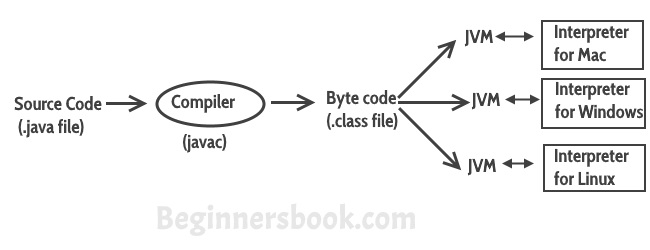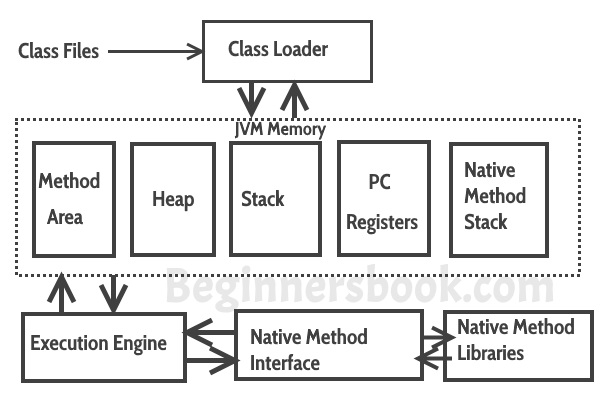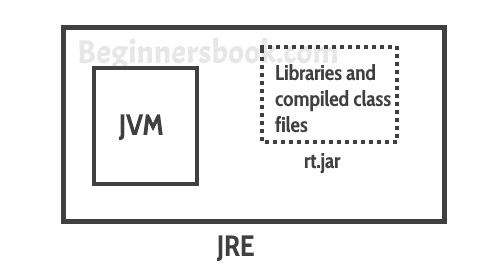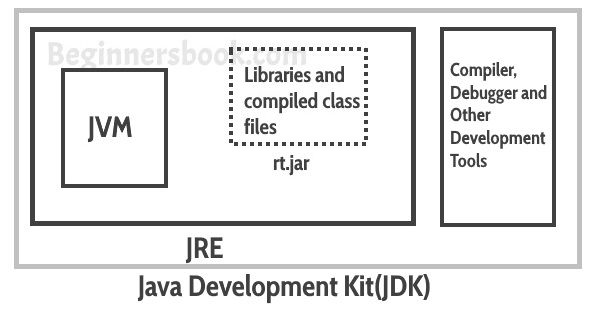Java Virtual Machine (JVM), Difference JDK, JRE & JVM – Core Java
By Chaitanya Singh | Filed Under: Learn Java
Java is a high level programming language. A program written in high level language cannot be run on any machine directly. First, it needs to be translated into that particular machine language. The javac compiler does this thing, it takes java program (.java file containing source code) and translates it into machine code (referred as byte code or .class file).
Java Virtual Machine (JVM) is a virtual machine that resides in the real machine (your computer) and the machine language for JVM is byte code. This makes it easier for compiler as it has to generate byte code for JVM rather than different machine code for each type of machine. JVM executes the byte code generated by compiler and produce output. JVM is the one that makes java platform independent.
So, now we understood that the primary function of JVM is to execute the byte code produced by compiler. Each operating system has different JVM, however the output they produce after execution of byte code is same across all operating systems. Which means that the byte code generated on Windows can be run on Mac OS and vice versa. That is why we call java as platform independent language. The same thing can be seen in the diagram below:
So to summarise everything: The Java Virtual machine (JVM) is the virtual machine that runs on actual machine (your computer) and executes Java byte code. The JVM doesn’t understand Java source code, that’s why we need to have javac compiler that compiles *.java files to obtain *.class files that contain the byte codes understood by the JVM. JVM makes java portable (write once, run anywhere). Each operating system has different JVM, however the output they produce after execution of byte code is same across all operating systems.
JVM Architecture
 Lets see how JVM works:
Lets see how JVM works:
Class Loader: The class loader reads the .class file and save the byte code in the method area.
Method Area: There is only one method area in a JVM which is shared among all the classes. This holds the class level information of each .class file.
Heap: Heap is a part of JVM memory where objects are allocated. JVM creates a Class object for each .class file.
Stack: Stack is a also a part of JVM memory but unlike Heap, it is used for storing temporary variables.
PC Registers: This keeps the track of which instruction has been executed and which one is going to be executed. Since instructions are executed by threads, each thread has a separate PC register.
Native Method stack: A native method can access the runtime data areas of the virtual machine.
Native Method interface: It enables java code to call or be called by native applications. Native applications are programs that are specific to the hardware and OS of a system.
Garbage collection: A class instance is explicitly created by the java code and after use it is automatically destroyed by garbage collection for memory management.
JVM Vs JRE Vs JDK
JRE: JRE is the environment within which the java virtual machine runs. JRE contains Java virtual Machine(JVM), class libraries, and other files excluding development tools such as compiler and debugger.
Which means you can run the code in JRE but you can’t develop and compile the code in JRE.
JVM: As we discussed above, JVM runs the program by using class, libraries and files provided by JRE. JDK: JDK is a superset of JRE, it contains everything that JRE has along with development tools such as compiler, debugger etc.
JDK: JDK is a superset of JRE, it contains everything that JRE has along with development tools such as compiler, debugger etc.
https://beginnersbook.com/2013/05/jvm/
Java Virtual Machine (JVM), Difference JDK, JRE & JVM – Core Java的更多相关文章
- JVM Specification 9th Edition (4) Chapter 3. Compiling for the Java Virtual Machine
Chapter 3. Compiling for the Java Virtual Machine 内容列表 3.1. Format of Examples 3.2. Use of Constants ...
- 60年代进程 80年代线程 IPC How the Java Virtual Machine (JVM) Works
小结: 1. To facilitate communication between processes, most operating systems support Inter Process C ...
- JVM Specification 9th Edition (3) Chapter 2. The Structure of the Java Virtual Machine
Chapter 2. The Structure of the Java Virtual Machine 内容列表 2.1. The class File Format (class文件的格式) 2. ...
- The Structure of the Java Virtual Machine Java虚拟机结构 虚拟机内存模型
小结: 1.实现一台Java虚拟机,只需正确读取class文件中的每一条字节码指令且能正确执行这些指令所蕴含的操作. 2.设计者决定:运行时数据区的内存如何布局,选择哪种垃圾收集算法,是否对虚拟机字节 ...
- What is the difference between JRE,JVM and JDK?
If you are a Java developer, it is very often that you think about understanding the JRE,JVM and JDK ...
- Java初学者不得不知的概念,JDK,JRE,JVM的区别?(转)
JVM(Java Virtual Machine Java虚拟机)可以理解为是一个虚拟出来的计算机,具备着计算机的基本运算方式,它主要负责将java程序生成的字节码文件解释成具体系统平台上的机器指令. ...
- JVM常用命令和性能调优建议 [Could not create the Java virtual machine]
一.查看jvm常用命令jinfo:可以输出并修改运行时的java 进程的opts. jps:与unix上的ps类似,用来显示本地的java进程,可以查看本地运行着几个java程序,并显示他们的进程号. ...
- java的概念了解(jdk,jre,jvm,javase,javaee,javame)
jvm jvm:java virtual machine,俗称:java虚拟机,只认识xxx.class这类文件 jre jre:java runtime environment,俗称java运行环境 ...
- 1、Java语言概述与开发环境——JDK JRE JVM理解
一.理解概念: 1.JDK(Java Development Kit Java开发工具包) JDK是提供给Java开发人员使用的,其中包含Java的开发工具,也包括JRE,所以安装了JDK,就不用单独 ...
随机推荐
- poj 2823 Sliding Windows (单调队列+输入输出挂)
Sliding Window Time Limit: 12000MS Memory Limit: 65536K Total Submissions: 73426 Accepted: 20849 ...
- 多线程之美5一 AbstractQueuedSynchronizer源码分析<一>
AQS的源码分析 目录结构 1.什么是CAS ? 2.同步器类结构 3.CLH同步队列 4.AQS中静态内部类Node 5.方法分析 5.1.acquire(int arg ) 5.2.rel ...
- .NET Core依赖注入集成Dynamic Proxy
在<Castle DynamicProxy基本用法>中介绍了如何将DP与Autofac集成使用,而 .NET Core有自己的依赖注入容器,在不依赖第三方容器的基础上,如何实现动态代理就成 ...
- Linux服务器部署.Net Core笔记:二、安装FTP
1.安装 安装ftp:yum install -y vsftpd 将ftp设置开机启动:systemctl enable vsftpd.service 2.配置 安装好后在ftp配置文件里进行配置 : ...
- 松软科技课堂:JS HTML DOM
通过 HTML DOM,JavaScript 能够访问和改变 HTML 文档的所有元素. HTML DOM(文档对象模型) 当网页被加载时,浏览器会创建页面的文档对象模型(Document Objec ...
- vue解惑之slot(插槽)
一.插槽是个什么玩意,能吃吗 在vue中[插槽],从字面意思来看,插槽意味着[内容的增加],回到vue的使用场景,插槽就是[父组件调用子组件时,额外增加的内容]. 插槽显不显示.显示的内容是由父组件来 ...
- 二维码生成插件qrious
1.qrious是基于canvas的纯JS二维码生成插件 1.1什么是二维码 二维码又称QR Code,QR全称Quick Response,是一个近几年来移动设备上超流行的一种编码方式,它比传统的B ...
- Python: simple code
# !/usr/bin/env python3.6 # -*- coding: utf-8 -*- # visual studio 2017 # 2019 10 12 Geovin Du print ...
- localStorage和sessionStorage的共同点和区别
共同点: 1.localStorage和sessionStorage都是用来存储客户端临时信息的对象. 2.他们均只能存储字符串类型的对象. 3.不同浏览器无法共享localStorage或sessi ...
- react + typescript 学习
react,前端三大框架之一,也是非常受开发者追捧的一门技术.而 typescript 是 javascript 的超集,主要特点是对 类型 的检查.二者的结合必然是趋势,不,已经是趋势了.react ...
